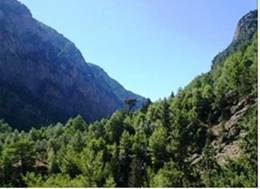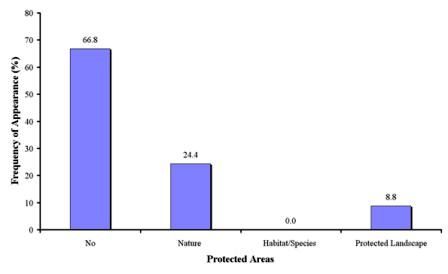Protected areas
This indicator includes areas important for conserving biodiversity, cultural heritage, scientific research, recreation, natural resource maintenance, and other values. These areas can be used to identify sustainable management practices to combat desertification. The aim of protected areas is to conserve biological resources, both common and rare, conserving ecosystems and preserving the ecological balance and promoting ecological tourism as part of the diversification of tourism. The World Conservation Union (IUCN) defines the following six management categories of protected areas in two groups: (1) totally protected areas; Category I, Strict Nature Reserves/Wilderness Area (Fig. 96); Category II, National Park; Category III, National Monument; (2) partially protected areas for specific uses such as recreation, or to provide optimum conditions for certain species or ecological communities with Category IV, Habitat/Species Management Area; Category V, Protected Landscape/Seascape; and Category VI, Managed Resource Protected Area (Fig.97). The coastal zone of the Mediterranean region includes many wetlands which play a crucial role in maintaining and enhancing environmental quality and providing valuable economic benefits through their many functions such as water purification, carbon sequestration, maintenance and equilibrium of the water cycle, hosting millions of migratory birds, and providing excellent environments for leisure. There are 81 Ramsar and numerous NATURA 2000 sites in European Union of great importance for protection and conservation of the Mediterranean ecosystems and their cultural heritage.


Fig. 97. Examples of totally protected area (Sanmaria canyon, Crete), and partially protected area (Cape Verde)
This indicator has been defined on the basis of the type of protected area such as: (a) nature reserves/wilderness, (b) national park, (c) national monument, (d) habitat/species management, (e) protected Landscape, and (f) managed resources. The degree of the implementation of existing regulations on environmental protection is assessed in the following indicator "policy enforcement".
As Table 15 shows, data for this indicator were selected in 295 field sites, corresponding to 8 study sites. The majority of the cases where field sites were described (66.8%) have been defined as non-protected areas (Fig. 98). Such field sites have described in the study sites of Boteti Area-Botswana, Gois-Portugal, Djanybek-Russia, Konya Karapinar plain-Turkey, and Mação- Portugal. Nature reserves/wilderness has been defined in 24.4% of the study field sites, corresponding to Eskisehir-Turkey, and Cointzio Catchment-Mexico study sites. Protected landscapes have been identified in 8.8% of the field sites in which this indicator has been described, corresponding in few cases to the study sites of Djanybek-Russia, Konya Karapinar plain-Turkey.

Fig. 98. Distribution of protected areas identified in the study field sites